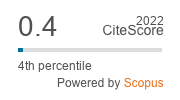Growth and development of Amrasca biguttula biguttula Ishida (Homoptera, Cicadellidae) during different seasons on okra
DOI:
https://doi.org/10.33307/entomon.v47i4.806Abstract
The influence of three seasons namely pre-kharif (Feb-May), kharif (May-Aug) and post-kharif (Aug-Nov) on the biology of jassid on okra under natural climatic conditions revealed that the developmental periods showed differences over seasons. The total nymphal period was longest in post-kharif (8.90±0.91days) followed pre-kharif (7.15±0.75 days) and the shortest during kharif (6.60±0.52 days). The longest total life span was observed in post-kharif (38.29±2.79) followed by pre-kharif (34.90±1.47 days) and shortest during kharif (33.75±1.89 days). Maximum eggs was laid in post-kharif (18.70±2.45 eggs/ female), followed by the pre-kharif (17.20±1.62 eggs/ female) and least in kharif (16.20±1.55 eggs/ female).


